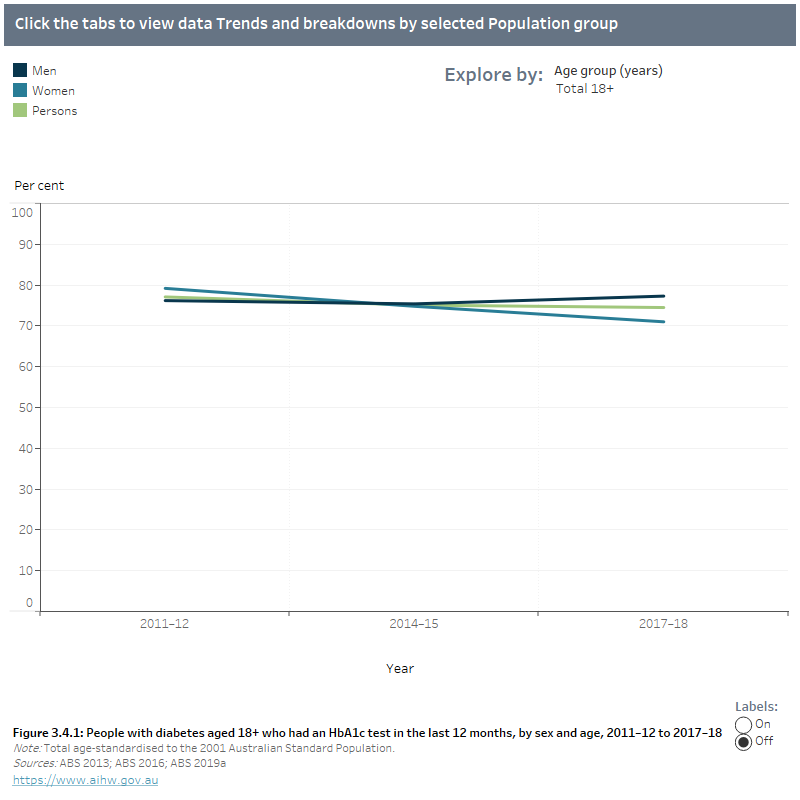3.4 People with diabetes who had an HbA1c test in the last 12 months
Consideration
These estimates are based on relatively small numbers and are associated with large sampling error.
Overview
In 2017–18, it was estimated that 71% of Australian adults with self-reported diabetes had an HbA1c test within the previous 12 months, based on data from the National Health Survey (NHS).
Trends
After adjusting for age, the proportion of Australian adults with diabetes who reported that they had an HbA1c test remained similar between 2011–12 and 2017–18 (77% compared with 75%, respectively) (Figure 3.4.1).
Age and sex
There were no differences between age groups, or by sex (Figure 3.4.1).
Population groups
The age-standardised proportion did not differ by socioeconomic areas and remoteness area (Figure 3.4.2). Due to small numbers, age-standardised proportions were not derived.
State and territory
The proportion of Australian adults with diabetes who reported that they had an HbA1c test in the previous 12 months was highest in South Australia (85%) and lowest in New South Wales (67%). Proportions across the other states and territories ranged from 70% to 82% (Figure 3.4.2). Due to small numbers, age-standardised proportions were not derived.
Aboriginal and Torres Strait Islander people
In 2018–19, an estimated 72% of Indigenous Australians with diabetes had an HbA1c test in the past year, based on measured data from the National Aboriginal and Torres Strait Islander Health Survey (NATSIHS). Based on estimates from the 2018–19 NATSIHS and 2017–18 NHS, the age-standardised proportion was similar for Indigenous and non-Indigenous adults (73% compared with 75%, respectively) (Figure 3.4.2).
About the data
Data for this indicator from the 2018–19 NATSIHS were only collected for non-remote areas. Therefore, results presented for non-Indigenous adults from the 2017–18 NHS only include non-remote areas.
It should be noted that the estimates obtained from the National Health Surveys are based on relatively small numbers and are associated with large sampling error. The lack of statistical significance does not necessarily mean that there is no difference between the estimates being compared.
Explore the data
3.4 People with diabetes who had an HbA1c test in the last 12 months, by sex and age, 2011–12 to 2017–18 and by selected population group, 2017–18
Trends figure 3.4.1 shows the proportion of people with diabetes who had an HbA1c test in the last 12 months remained stable between 2011-12 and 2017-18 at 77% and 75% respectively. There was little difference among age groups and by sex during this period.
Population group figure 3.4.2 shows in 2017-18 around 75% of people with diabetes had an HbA1c test in the last 12 months. Proportions were similar among age groups and slightly higher among males (77%) than females (71%). Proportions were similar by Indigenous status, remoteness area and socioeconomic area with around 73% of Indigenous Australian having an HbA1c test in the last 12 months. Among the states and territories, the proportion of people with diabetes who had an HbA1c test in the last 12 months in was similar, ranging from 70% in the Northern Territory to 85% in South Australia.

| Definition | Data source | |
|---|---|---|
|
Numerator |
Estimated number of adults (18+ years) with self-reported diabetes who had an HbBA1c test in the previous 12 months. Included people with type 1 diabetes, type 2 diabetes, and type unknown. |
ABS 2019a; ABS 2019b; ABS 2016; ABS 2013 |
|
Denominator |
Estimated number of adults (18+ years) with self-reported diabetes. Included people with type 1 diabetes, type 2 diabetes, and type unknown. |
ABS 2019a; ABS 2019b; ABS 2016; ABS 2013 |
Australian Bureau of Statistics (ABS) 2013. Microdata: Australian Health Survey, National Health Survey, 2011–12. ABS cat. no. 4324.0.55.001. Findings based on Detailed Microdata analysis. Canberra: ABS.
ABS 2016. Microdata: National Health Survey, 2014–15. ABS cat. no. 4324.0.55.001. Findings based on Detailed Microdata analysis. Canberra: ABS.
ABS 2019a. Microdata: National Health Survey, 2017–18. ABS cat. no. 4324.0.55.001. Findings based on Detailed Microdata analysis. Canberra: ABS.
ABS 2019b. Microdata: National Aboriginal and Torres Strait Islander Health, Australia, 2018–19. ABS cat. no. 4715.0.55.001. Findings based on Detailed Microdata analysis. Canberra: ABS.


